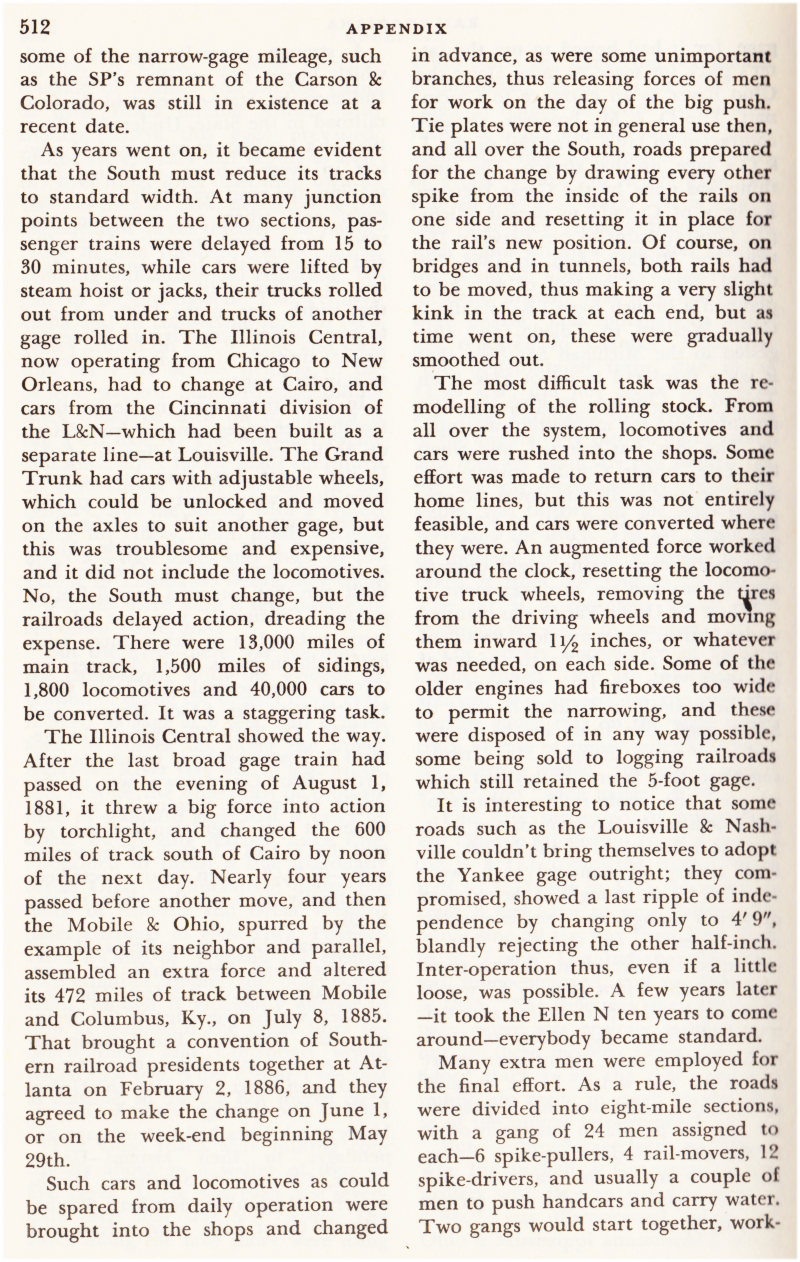A lazy post this started out to be. However, I started opening books. Hopefully, some of these diverse approaches to the track gauge will inspire curiosity in some non-rail enthusiasts who may find them in the future. I don't think it hurts to put some of these original sources together in the same place.
We start with the origin of 'Stephenson Gauge' ... in Britain.
 |
| The Railways of Britain; OS Nock; 1947; Batsford. |
 |
| The Railways of Britain; OS Nock; 1947; Batsford. |
* * *
A photo of the Great Western Railway ...
 |
| Railways in Camera; Robin Linsley; 1996; Alan Sutton Publishing. |
The skills of trackworkers who laid switches in dual-gauge territory are always interesting to contemplate. In one direction or the other, some workers seem to have ghost-traversed the walkway during the period the film was exposed. A portion of the photo is enlarged below in an attempt to show a little more detail of the trackwork. Interlocking rods can also be seen - eg. passing underneath the walkway.
The Great Western operated as a broad gauge (7 foot) railway from 1838 until 1892.
 |
| Railways in Camera; Robin Linsley; 1996; Alan Sutton Publishing. |
 |
| The Railways of Britain; OS Nock; 1947; Batsford. |
W. Heath Robinson b1872, Islington - d1944 London, UK ...
(like American Rube Goldberg 1883-1970)
was an illustrator who became known for his elaborate humourous cartoons.
One of the early Bletchley Park decryption computers was named for Robinson.
* * *
(like American Rube Goldberg 1883-1970)
was an illustrator who became known for his elaborate humourous cartoons.
One of the early Bletchley Park decryption computers was named for Robinson.
* * *
From: A Treasury of Railroad Folklore; Botkin & Harlow; 1953; Bonanza Books.
This interesting article was to have been my entire post ...
The article continues below the next image.
 |
| Delaware & Hudson; Jim Shaughnessy; 1972; Howell-North. |
Here is a view of the Delaware & Hudson's 4 foot, 3 inch gauge operation. The use of stationary engines to haul cars upgrade and the use of only brakeman (without motive power) to manage train descent had already been used in Britain.
A passenger engine at Valley Junction is pushing coal cars to the foot of Plane 23 and the cut will be pulled north toward Carbondale.
... a couple of additional images from this operation follow the completion of the article.
* * *
The article continues below ...
* * *
 |
| Travelers Official Railway Guide; June 1868; National Railway Pub. Co - Reprint. |
Above and below: The New York & Erie ... later becoming the Erie ... operated as a 6 foot gauge railway from 1832. Between 1876 and 1880 it was converted to Standard Gauge. It seems that the decision to use the 6 foot gauge doomed the railway to poor financial performance and a few 'financial reorganizations' during its entire broad gauge existence.
 |
| History of Railroads in America; Oliver Jensen; 1975; American Heritage. |
* * *
A little more on the Delaware & Hudson ...
 |
| Delaware & Hudson; Jim Shaughnessy; 1972; Howell-North. |
A three car passenger train pauses at the Shepherd's Crook on the Delaware & Hudson gravity line. The line descended (uninterrupted) for 14 miles from Farview to Archbald.
The 4 foot, 3 inch gravity line operated from 1829 until 1899. As you might expect, its passenger operation was more for local transportation, with some tourist interest. It was not part of the US national railway grid as a passenger railroad.
 |
| Delaware & Hudson; Jim Shaughnessy; 1972; Howell-North. |
* * *
Meanwhile in Canada ...
the term: 'superincumbent pressure'!
 |
| The Railways of Canada; JM & Edward Trout; 1871; Coles Reprint. |
 |
| The Railways of Canada; JM & Edward Trout; 1871; Coles Reprint. |
 |
| The Railways of Canada; JM & Edward Trout; 1871; Coles Reprint. |
 |
| The Railways of Canada; JM & Edward Trout; 1871; Coles Reprint. |
In Canada, the Grand Trunk and Great Western operated as five foot, six inch gauge railways
from their inception in the mid-1850s ...
until circa 1870 (Great Western)
with the Grand Trunk converting to Standard Gauge between 1872 and 1885.
 |
| The Railway Builders; Oscar D Skelton; 1916; Glasgow Brook & Co. |
* * *
Now, some general musings on the history of track gauge in Canada from Omer Lavallee ...
 |
| Narrow Gauge Railways of Canada; Omer Lavallee; 1972; Railfare. |
 |
| Narrow Gauge Railways of Canada; Omer Lavallee; 1972; Railfare. |
 |
| Narrow Gauge Railways of Canada; Omer Lavallee; 1972; Railfare. |
 |
| Narrow Gauge Railways of Canada; Omer Lavallee; 1972; Railfare. |
To finish off with another nice display of dual-gauge track laying ...
A narrow gauge 4-4-0 switches in the Charlottetown, PEI yard ... with the standard gauge coaches of the train to Borden to the right.







